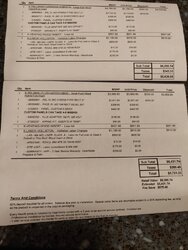I first would like to thank you in advance for your input.
After my first post, done about two weeks ago, I have decided that I would not install a wood stove but now I will install a wood insert.
I also want to add that I am a complete NOOB and I still am partially confused.
I did visit my local dealer regarding a FireplaceX insert, as you know I have a corner fireplace and FireplaceX does custom paneling.
Does anyone have any insight with the hybrid wood inserts of FireplaceX?
So I have a few questions.
1. I am looking to get a catalyst insert, one with a clean burn. Is this bad? Or Good? What are some of the cons of this verse a non-catalyst insert?
2. I am torn between their only two sizes for their catalyst insert, small or large.
Small is 1.2 Cubic Foot, up to 1,000 sf with 47,000 BTU/h, with .89 grams/hr for emissions and 76.5% efficiency.
Large is 3.0 Cubic Foot, up to 2,500 sf with 83,220 BTU/h, with .58 grams/hr for emissions and 80.3% efficiency. My place is about 1,800 sf, two floors and a loft.
3. I have attached two quotes, one for the smaller version and one for the larger version. I mentioned (based on my reading of other posts), that it may be better to put in a insulated liner and I was told no. They block the top of the insert with insulation (some kind of damper wall) and also block off the top with a cap and I don’t need or want a insulated liner since it will go through my chimney. What is your opinion?
OK, so my preference would be the larger insert only because it has a nicer look and a bigger viewing window. The shop tells me I can use the larger insert and just not burn at it’s highest levels. Does this sound right?
Now I don’t have to use FireplaceX, but my local dealer does carry that brand and gets very good reviews regarding the install and service. I am still opened to anything… just want to get your opinion before I make the plunge.
The last cost not listed is that I need to get a plug installed into my fireplace.
Thanks again.

After my first post, done about two weeks ago, I have decided that I would not install a wood stove but now I will install a wood insert.
I also want to add that I am a complete NOOB and I still am partially confused.
I did visit my local dealer regarding a FireplaceX insert, as you know I have a corner fireplace and FireplaceX does custom paneling.
Does anyone have any insight with the hybrid wood inserts of FireplaceX?
So I have a few questions.
1. I am looking to get a catalyst insert, one with a clean burn. Is this bad? Or Good? What are some of the cons of this verse a non-catalyst insert?
2. I am torn between their only two sizes for their catalyst insert, small or large.
Small is 1.2 Cubic Foot, up to 1,000 sf with 47,000 BTU/h, with .89 grams/hr for emissions and 76.5% efficiency.
Large is 3.0 Cubic Foot, up to 2,500 sf with 83,220 BTU/h, with .58 grams/hr for emissions and 80.3% efficiency. My place is about 1,800 sf, two floors and a loft.
3. I have attached two quotes, one for the smaller version and one for the larger version. I mentioned (based on my reading of other posts), that it may be better to put in a insulated liner and I was told no. They block the top of the insert with insulation (some kind of damper wall) and also block off the top with a cap and I don’t need or want a insulated liner since it will go through my chimney. What is your opinion?
OK, so my preference would be the larger insert only because it has a nicer look and a bigger viewing window. The shop tells me I can use the larger insert and just not burn at it’s highest levels. Does this sound right?
Now I don’t have to use FireplaceX, but my local dealer does carry that brand and gets very good reviews regarding the install and service. I am still opened to anything… just want to get your opinion before I make the plunge.
The last cost not listed is that I need to get a plug installed into my fireplace.
Thanks again.

Last edited by a moderator:


